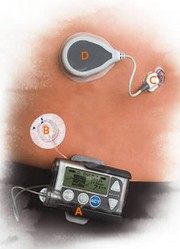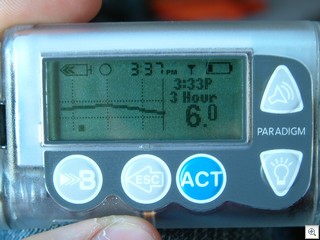New integrated real-time glucose meter and pump coming THIS SUMMER
 This is potentially HUGE. If you're not diabetic (likely you're not) then at least revel in the geek of it. Amy beat me to it on her blog, DiabetesMine, but maybe I'll be able to add a little detail.
This is potentially HUGE. If you're not diabetic (likely you're not) then at least revel in the geek of it. Amy beat me to it on her blog, DiabetesMine, but maybe I'll be able to add a little detail.
Today I received this email from my local Insulin Pump rep:
On April 12th, 2006 our new Paradigm REAL-Time System was approved by the FDA. This is the first-ever insulin pump with REAL-time glucose sensing capability, and is a huge step towards our goal of creating the artificial pancreas.
If you are not currently on an insulin pump and would like to know more about this, please feel free to contact me at the information listed below. If you are already on a MiniMed pump, I encourage you to visit our website, www.minimed.com , or call 1-800-MINIMED to find out how you can upgrade to this new insulin pump system.
Medtronic Diabetes (MiniMed) is very excited to offer you this breakthrough technology! Please feel free to contact me locally if you have any questions. To see a demonstration of this new system, please attend one of our many “Pump events”. You can see a list of events and sign up for one at www.minimed.com/events .
This is huge. If a number of things come together, I should be hooked up to this system in mid-June. Here's the back story.
Shots ten years ago: For years I took shots, as did and as do many Type 1 diabetics, to keep my blood sugar down. (More detail in my Diabetes: Airplane Analogy) You eat, food turns into glucose and your blood sugar goes up as your body is missing insulin, the hormone needed to deliver the sugar to your cells. Typically this is done with two kinds of Insulin, one that's short acting (starts working in an hour and lasts about 6 hours) that you inject at every meal, and one long acting that is running "in the background" that you inject 2-4 times a day.
Shots today: Today, there are newer insulins, a short acting one that starts working in minutes and lasts a few hours, and a long acting one that lasts for 24 hours that you only have to inject once. This means, wake up, take a shot for the background insulin, then take a shot for each meal. This is a great therapy if you stick to it. It's often called the "poor man's pump."
Pumps a few years ago: My insulin pump is a delivery device, that's it. It is a tube about 3 feet long that is stuck into me with a 9mm needle/canula. I'm connected to it 24 hours a day, except for a few minutes in the shower. I prick my fingers 8-10 times a day to draw blood and check my sugar levels. A few years back I'd do some calculations in my head and decide how much insulin the pump should give me. The pump was ignorant and just followed orders.
Pumps this year: Newer pumps, like the one I have now can communicate wirelessly (one way, receiving information only) with my blood sugar meter. I prick my finger and the meter "announces" the blood sugar value and the pump records it. Since the pump knows how much insulin it's been delivering, it can do the math for me and make suggestions as to how much insulin I should take. It doesn't do anything automatically, but it does suggest and I "close the loop." The "closed loop" system is the Holy Grail of Diabetes Management - a system that checks sugar automatically, delivers insulin automatically and keeps me alive automatically (presumably without mistakes.
 Pumps starting in June (yay!): The new Paradigm 522 communicates wirelessly with another device that'll be attached nearby (see the picture at the upper right). The sensor tests every ten seconds and averages to give you a new value every five minutes. It'll give you an alarm if your numbers go out of your specified range. The pump still needs you (me) to "close the loop" and press OK when it makes a suggestion. However, this is very promising because the next obvious step is implanting the whole apparatus, pump and meter, in your torso and managing it with a watch-like remote - an artificial pancreas. The big negative is that you have to change the sensor every three days and they are $30 a pop. That'd mean $300 a month if you wanted to have it working all the time. You don't HAVE to have the continuous equipment hooked up all the time, you could use it just when travelling or when things are going smoothly. Hopefully the price for the equipment will drop soon or be covered by US insurance.
Pumps starting in June (yay!): The new Paradigm 522 communicates wirelessly with another device that'll be attached nearby (see the picture at the upper right). The sensor tests every ten seconds and averages to give you a new value every five minutes. It'll give you an alarm if your numbers go out of your specified range. The pump still needs you (me) to "close the loop" and press OK when it makes a suggestion. However, this is very promising because the next obvious step is implanting the whole apparatus, pump and meter, in your torso and managing it with a watch-like remote - an artificial pancreas. The big negative is that you have to change the sensor every three days and they are $30 a pop. That'd mean $300 a month if you wanted to have it working all the time. You don't HAVE to have the continuous equipment hooked up all the time, you could use it just when travelling or when things are going smoothly. Hopefully the price for the equipment will drop soon or be covered by US insurance.
An acquaintance of mine, and fellow diabetic, Chris Jarvis is a member of the 2004 Canadian Olympic Rowing team and all-around bad-ass. He's been using a new Paradigm 522 Insulin Pump and Continuous Glucose Meter for a while now. (Canada got this pump before the US.) He and his team of 7 others diabetics ran the Boston Marathon recently all wearing continuous meters and have compiled a lot of data on how the diabetic body works while doing things like running marathons. He's been so kind as to allow me to upload some PDFs that the pump/meter/software combination creates. The statistical data here is fantastic. The difference between 1400 readings and 10 is significant. ;) Thank you Chris for sharing something so personal as your health information.
File Attachment: 7 day trend analysis.pdf (36 KB)
File Attachment: 14 day trend.pdf (31 KB)
File Attachment: Daily Summary.pdf (31 KB)
Do check out his site at http://www.insulindependence.org.
Also, we're still raising money for Team Hanselman and the Walk for Diabetes on May 6th. We raised over $11,000 pushing right through our goal of $10k. Let's raise that goal to $15 and see if we can't make it happen before May 6th! Thanks to everyone for their fantastic support. Forward the link to your friends and family!
About Scott
Scott Hanselman is a former professor, former Chief Architect in finance, now speaker, consultant, father, diabetic, and Microsoft employee. He is a failed stand-up comic, a cornrower, and a book author.
About Newsletter
This new technology is so cool it makes me (Type 2) wish my control was worse so I could justify getting one :-)
I'm gonna look into getting just the Guardian RT system for now instead, though the minimed folks don't seem all that interested in Type II users judging by the questions they ask on the More Info page for the Guardian system.
As far as a closed loop system goes, I would be scared to have it on at night. If something goes wrong during the day (as far as too much insulin) no big deal, but if you are sleeping? Your body will wake you up if you drop too low, but my experience tells me it all depends on a number of factors. Maybe if they release an API for it we can tie it into a PA system or car alarm.
Would you please tell me how much is it?
Thanks
Thanks so much for putting all the info out there.
Margie
PS... activity and exercise seem to have the biggest influence on my sugars. I used to run 9-10 miles a day without even having to eat... now I can barely do yard work without flaking out.
I agree that the Minimed development is VERY EXCITING. A few years ago at a Minimed pump meeting, they showed the graphs of a closed loop circuit in a dog and I couldn't help tearing up about that it was so awesome.
If you haven't already readd about it, you might also see what Dr. Faustman is doing at Mass General with her research on curing Type I diabetes. More at http://www.mgh.harvard.edu/diabetes/%5Claboratory_type1.htm.
This is the first research I've seen that has given me some hope (over 30 years with Type I now and counting). Lee Iacocca is raising funds to sponsor this research, more at his JoinLeeNow site (http://www.joinleenow.org/).
Best of luck with your fund raising for ADA, speaking as a former advocate for them they're a great team.
Comments are closed.
